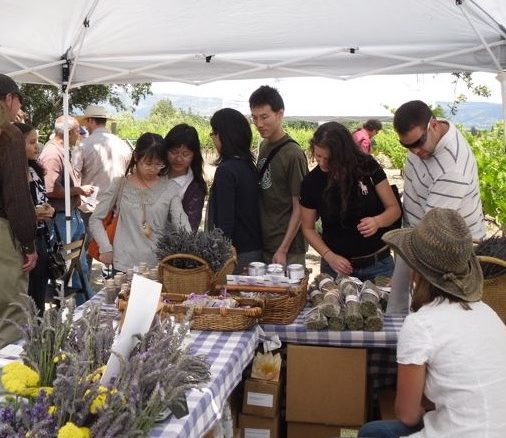The Uneasy Marriage of Agriculture and Tourism
When did agriculture become so entangled with tourism? This question is foundational in the land-use issues that are spreading as fast as wild fire in Napa, Sonoma, Mendocino, and Lake Counties. In Napa County after 2010 and the Winery Definition Ordinance, direct marketing has officially become an agricultural activity which includes tasting rooms, food pairings and commercial kitchens, and events with hundreds of visitors. Of course, this brings the unintended consequences of impingement on the environment, traffic, air quality, and the fabric of our community. But long before 2010, agriculture was finding ways to get people onto farms and buying product, all a subset of what is also called eco-tourism.
My husband Donald and I are personally involved with this. Our aromatics and lavender are estate grown and distilled. Early on we began the ritual of an annual open house to introduce people to our products as well as to educate about the way we practice Biodynamic agriculture.
We held the open house in mid June when the lavender was in full bloom. At first, the open house was lightly attended, but after a couple of years—and several articles in the local paper, magazines, and a notice in the New York Times— we suddenly had almost more people than we could possibly handle. Donald spent all day helping people park, trying to keep them off the road and its dangerous curve. We had speakers come to talk about native plants, native wisdom, and the uses of lavender. We gave tours and we sold product. People were hungry for a less glitzy experience than that of the large wineries (this was definitely less glitzy!) I hope it also stimulated an awareness of the earth under their own home.
Patricia leading tour of ranch and explaining our biodynamic system.But at some point that tipping point happened; the tourism element was like a tidal wave. More and more were not local people, but tourists in search of an “authentic experience”. Suddenly our ranch and our home was viewed as a public place— also an unintended consequence. People showed up unannounced most summer weekends. And what if we did this every weekend, not just once a year?
Yes, visitation increases sales. It did for us. But visitation also severely impacts the neighborhood with traffic and noise, and as we get more and more people, and more and more wineries and small farms direct marketing their products through events (event centers) and tasting rooms, that becomes problematic.
Agriculture is about relationship with the earth. Yes, the farmer— or grower—or distiller— or winemaker—needs to make a profit, but should that profit be on the back of the neighbors, of Nature, of the social fabric in which a community evolves into a tourist economy?
I believe that there can be balance. What if we had a system like Farm Trails (Wine Trails?) with designated times in the year when small wineries/farms tucked into the Ag Preserve and Ag Watershed zones are open for visitation? Direct marketing would still have an onsite venue, but would more heavily depend on other methods: skilled use of internet marketing, wine tasting shops downtown which stimulate other businesses (two birds with one stone!), and the creative cultivating of relationships built through the “events” happening three or four times a year—at most!
I have heard it said that the “myth” of the small winemaker is a hijacking of the term by the wine industry to push their own corporate agendas. But there really are a number of us growers (and we don’t all grow only grapes!), distillers, and winemakers who are legitimate small businesses and need to market our products. There are ways to do it without further damaging our environment. Perhaps this idea of direct marketing needs to be considered in a much more substantive way that considers the realities of the commons and returns agriculture’s prime aim to stewardship of the earth.
